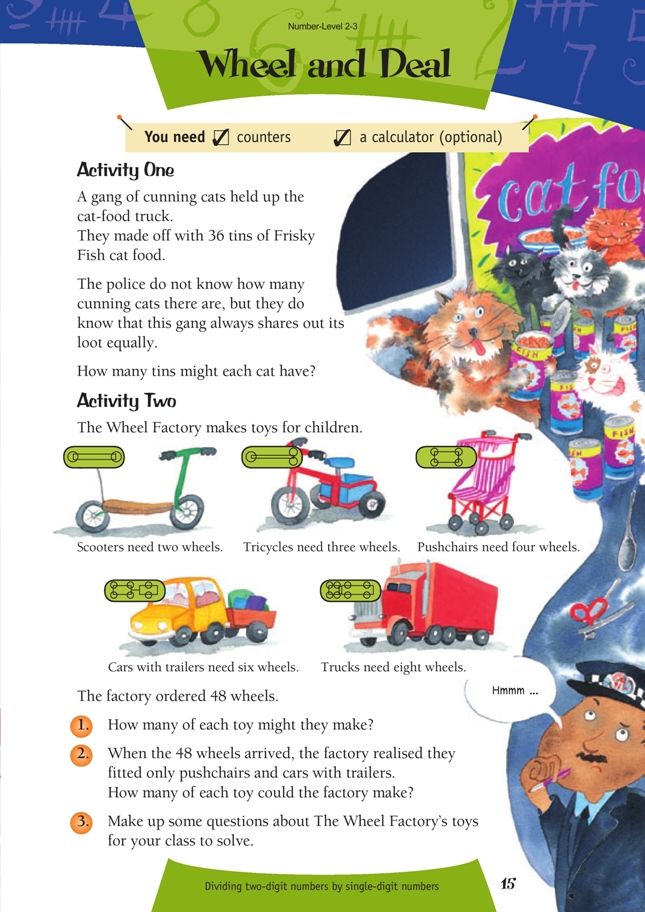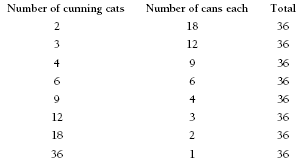This is a level 3 number activity from the Figure It Out series. It relates to Stage 6 of the Number Framework.
A PDF of the student activity is included.
Click on the image to enlarge it. Click again to close. Download PDF (254 KB)
use multiplication facts to solve problems
FIO, Level 2-3, Number, Wheel and Deal, page 15
Calculator (optional)
Activity One
Students will need to investigate which numbers of cats will work to give an even share with no cans left over. This can be acted out with the students playing the cunning cats and multilink cubes representing the tins of cat food.
Encourage students to apply their knowledge about multiplication and division to the problem. For example:
“Six sixes are 36, so there could be six cunning cats getting six cans each.”
Organise the results students come up with in a table so that students can notice patterns:
In this way, students may see that finding two factors of 36 gives two solutions (the commutative property). Changing the number of cans in the problem to 42 provides another opportunity to assess whether students can apply what they have learned.
Activity Two
Question 1 involves dividing the number 48. Some students will need access to counters (to use as wheels) to model the problem. Encourage these students to predict how many of a given type of vehicle they will be able to make. Other students will see the connection with multiplication and division. Ask them to record their solutions, using equations such as:
3 x 16 = 48 or 48 ÷ 3 = 16
For less able students, this problem can be simplified by reducing the number of vehicles made and the total number of wheels available.
Question 2 involves investigating the possible vehicles in an organised way. For example, a student might know that eight cars with trailers can be made because 8 x 6 = 48. From that, they may realise that reducing the number of cars with trailers to six frees up 12 wheels (2 x 6), so three pushchairs can be made. The pattern continues with four cars with trailers and six pushchairs or two cars with trailers and nine pushchairs being made.
Answers to Activities
Activity One
36 cats would get 1 tin each.
18 cats would get 2 tins each.
12 cats would get 3 tins each.
9 cats would get 4 tins each.
6 cats would get 6 tins each.
4 cats would get 9 tins each.
3 cats would get 12 tins each.
2 cats would get 18 tins each.
Activity Two
1. Answers will vary. If at least one of each toy is made, four possible answers are:
• 2 scooters, 2 tricycles, 4 pushchairs, 1 car with trailer, and 2 trucks
• 3 scooters, 2 tricycles, 2 pushchairs, 2 cars with trailers, and 2 trucks
• 1 scooter, 2 tricycles, 3 pushchairs, 2 cars with trailers, and 2 trucks
• 2 scooters, 2 tricycles, 1 pushchair, 3 cars with trailers, and 2 trucks
If the 48 wheels were used to make only one type of toy, the factory could make 24 scooters, 16 tricycles, 12 pushchairs, 8 cars with trailers, or 6 trucks.
2.
3. Answers will vary.


